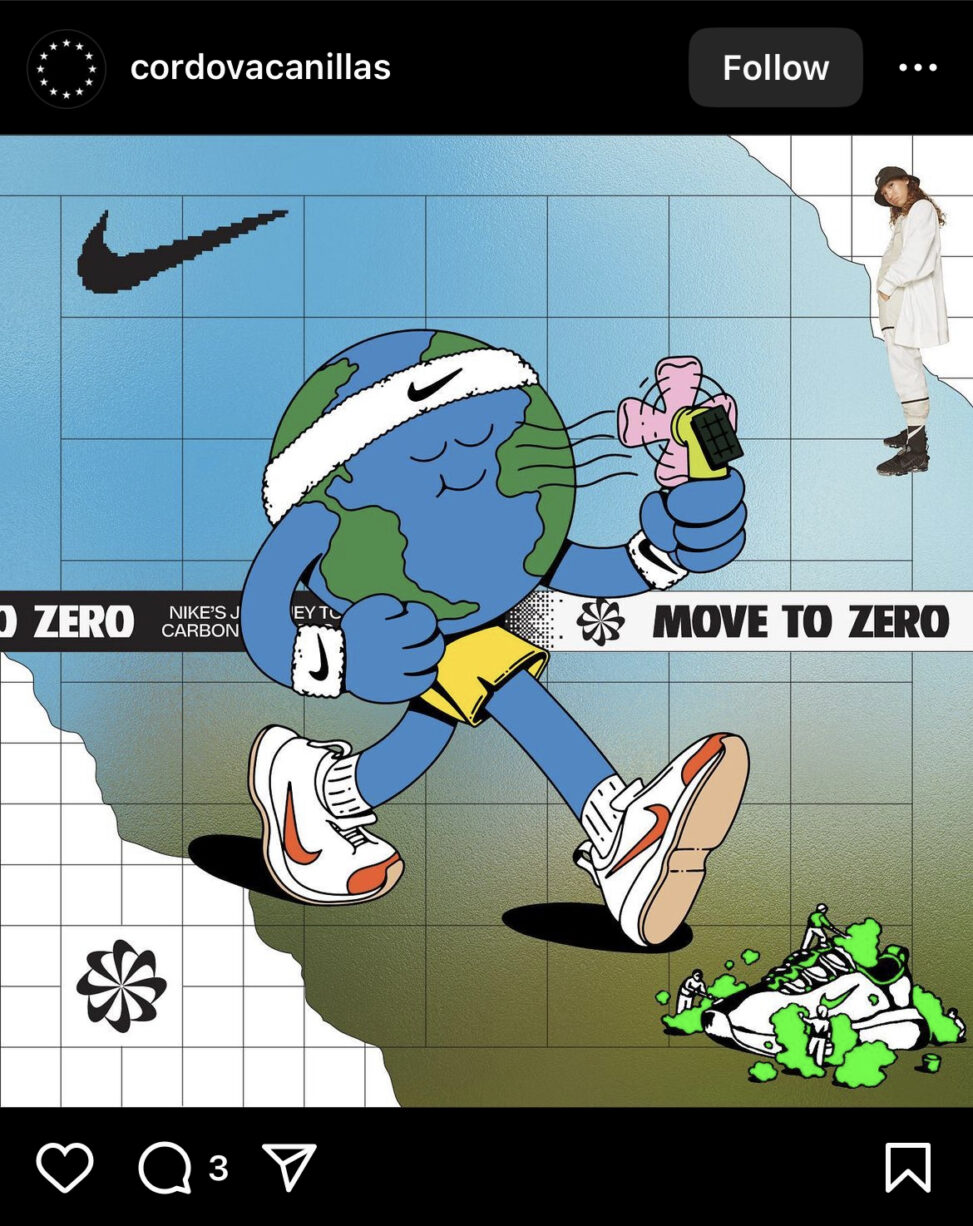Nike is a very large and well-known brand around the world. This makes them obligated to have some kind of green initiative in today’s society. This Nike initiative is called “Move to Zero.” The idea of it is to reuse materials to invent other ones for their products. According to their Move to Zero page on the official Nike website, this makes them “green” by reducing their greenhouse gas emissions, diverting landfill waste to be recycled and used in their products, and a reduction in their water usage (Nike.com).
I spotted this still ad while scrolling on Instagram and felt that it would be a great one to analyze. The ad caught my attention firstly with the Nike logo in the top left-hand corner. The colours and animated graphic of the Earth wearing Nike gear was what made me stop and see what it was about. When you look closer you can also spot a model sporting Nike clothing and shoes in the top right corner, as well as what appears to be little workers scrubbing down a Nike shoe in the bottom right, although I am not entirely sure what that represents. The Earth character is also sporting Nike gear, including a headband, two sweatbands, and some white and orange sneakers. The character is also smiling while cooling themselves down with a handheld fan, which appears to be solar powered. Lastly, Nike’s “Move to Zero” slogan and circular logo appear in a straight horizonal banner in the background of the image. The advertisement is clearly conveying that Nike is an eco-friendly brand with initiative to be more “green,” by promoting their initiative, Move to Zero.
With advertisements like this, Nike appears to be a somewhat eco-friendly brand, but are they really using green practices as much as they portray? According to a study done by the University of Utah, Nike actually has some weakness within their material sourcing. Reportedly, Nike uses a lot of materials in their products for performance, comfort, and aesthetics that does not match up with their green practices. Their top five most used materials are polyester, cotton, rubber, leather, and ethylene-vinyl acetate foam. When you look at the numbers from the University of Utah, you can see that these materials are not generally recycled materials. Of the 76,141 metric tons of rubber used from 2020 to 2022, only 564 metric tons (0.7%) were of recycled rubber. Another big factor in their material sourcing is leather, “leather production is one of the highest-impact materials for both carbon emissions and waste across the footwear and apparel industry,” (Huynh 2023). Considering Nike used 51,646 metric tons of the material from 2020 to 2022, it would have had a significantly negative environmental impact.
According to a 2023 Georgetown Environmental Law Review Article by Charlie Dwight, Nike ran into some trouble in May of 2023 when a class action complaint was filed against them. The complaint stated that “Nike falsely and misleadingly represented their products as sustainable, made with sustainable materials, and environmentally friendly,” (Dwight 2023) essentially accusing Nike of Greenwashing. It was claimed that Nike actually violated the Missouri Merchandising Practices Act, unjustly enriched themselves, misrepresented themselves without caring, and were fraudulently acting eco-friendly. The Nike “Move to Zero” initiative that was mentioned earlier is supposed to reduce waste, attempt a zero carbon and waste usage, and be environmentally friendly. However, the complaint argued that “less than ten percent of those products are made with recycled materials,” (Dwight 2023), referring to the Move to Zero product collection. The complaint indicated that these products were made up of mostly plastic-based and non-bio-degradable materials like nylon and polyester. These materials take a large amount of energy to use.
To sum up the Nike ad analysis, the brand appears to be doing a good job of promoting and attempting a green initiative to the public and their consumers. However, with a deeper dive into Nike and its practices, it’s visible they still have some work to do in order to follow up on their eco-friendly goals.
Biography
Dwight, Charlie. “Greenwashing: The Beginning or End of Environmental Deception.” The Georgetown Environmental Law Review, (2023). Accessed September 28, 2024. https://www.law.georgetown.edu/environmental-law-review/blog/greenwashing-the-beginning-or-end-of-an-era-of-environmental-deception/.
Huynh, University of Utah. “Nike and Environmental Sustainability.” Recommendation Report, (2023). Accessed September 24, 2024. https://writing.utah.edu/_resources/documents/2024/awards-papers/jacqueline-huynh-paper.pdf.
“Sustainability.” Nike, (2024). Accessed September 27, 2024. https://www.nike.com/ca/sustainability.


Emilia Caiza
In the post “Nike Eco-Friendly Ad” from Riley, the greenwashing practices of Nike were analyzed. Riley mentioned that Nike has implemented a new movement called “Move to Zero”, which is meant to used recyclable landfill waste in their products, as well as to help with the reduction of their greenhouse gas emissions and water usage. Still, these claims were shown to be unreliable. A study from the University of Utah reveled that most of the materials used by Nike are not generally recycled and that their used of leather has cause the opposite effect desired by their initiative (Huynh 2023 as cited in Riley 2024). Additionally, the company has faces legal accusation for violating the Missouri Merchandising Practices Act by using materials that are plastic based, which shows that Nike still only has a superficial level of green practices (Dwight 2023 as cited in Riley 2024).
As for the description of the advertisement, although the different elements of the image were described, it was not done in much detail. I think the image tells the viewers that by using all or more than one Nike product, they are causing a reduction in the climate change, i.e., making the Earth cooler, which could also be used as a pun for the slang “cool”. Another important detail is the sources used to support the claims made. In the case of: “Recommendation Report: Nike and Environmental Sustainability” by Huynh (2023), even when published by a university, is still considered a student paper due to the absence of as peer review. Either way, it brings a great insight into the problematic practices of Nike.
-Emilia Caiza.